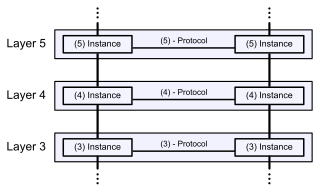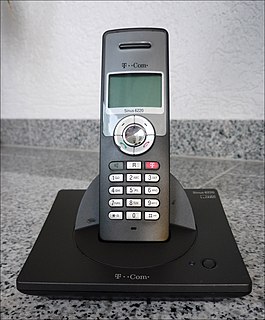
The Open Systems Interconnection model is a conceptual model that characterises and standardises the communication functions of a telecommunication or computing system without regard to its underlying internal structure and technology. Its goal is the interoperability of diverse communication systems with standard communication protocols.
The Common Management Information Service (CMIS) is the service interface specified in ITU-T Recommendation X.710, ISO/IEC International Standard 9595 that is employed by OSI network elements for network management. It defines the service interface that is implemented by the Common Management Information Protocol (CMIP) as specified in ITU-T Recommendation X.711, ISO/IEC International Standard 9596-1. CMIS is part of the Open Systems Interconnection (OSI) body of international network standards.
The Intelligent Network (IN) is the standard network architecture specified in the ITU-T Q.1200 series recommendations. It is intended for fixed as well as mobile telecom networks. It allows operators to differentiate themselves by providing value-added services in addition to the standard telecom services such as PSTN, ISDN on fixed networks, and GSM services on mobile phones or other mobile devices.

X.25 is an ITU-T standard protocol suite for packet-switched data communication in wide area networks (WAN). It was originally defined by the International Telegraph and Telephone Consultative Committee in a series of drafts and finalized in a publication known as The Orange Book in 1976.
In the seven-layer OSI model of computer networking, the physical layer or layer 1 is the first and lowest layer; The layer most closely associated with the physical connection between devices. This layer may be implemented by a PHY chip.
Signalling System No. 7 (SS7) is a set of telephony signaling protocols developed in 1975, which is used to set up and tear down telephone calls in most parts of the world-wide public switched telephone network (PSTN). The protocol also performs number translation, local number portability, prepaid billing, Short Message Service (SMS), and other services.
The Message Transfer Part (MTP) is part of the Signaling System 7 (SS7) used for communication in Public Switched Telephone Networks. MTP is responsible for reliable, unduplicated and in-sequence transport of SS7 messages between communication partners.
FCAPS is the ISO Telecommunications Management Network model and framework for network management. FCAPS is an acronym for fault, configuration, accounting, performance, security, the management categories into which the ISO model defines network management tasks. In non-billing organizations accounting is sometimes replaced with administration.
The Common Management Information Protocol (CMIP) is the OSI specified network management protocol.
Element management is concerned with managing network elements on the network element management layer (NEL) of the TMN . An element management system (EMS) manages one or more of a specific type of telecommunications network elements (NE).
The Open Systems Interconnection protocols are a family of information exchange standards developed jointly by the ISO and the ITU-T. The standardization process began in 1977.

ITU-T Recommendation Q.931 is the ITU standard ISDN connection control signalling protocol, forming part of Digital Subscriber Signalling System No. 1. Unlike connectionless systems like UDP, ISDN is connection oriented and uses explicit signalling to manage call state: Q.931. Q.931 typically does not carry user data. Q.931 does not have a direct equivalent in the Internet Protocol stack, but can be compared to SIP. Q.931 does not provide flow control or perform retransmission, since the underlying layers are assumed to be reliable and the circuit-oriented nature of ISDN allocates bandwidth in fixed increments of 64 kbit/s. Amongst other things, Q.931 manages connection setup and breakdown. Like TCP, Q.931 documents both the protocol itself and a protocol state machine.
A service delivery platform (SDP) is a set of components that provides a service(s) delivery architecture for a type of service delivered to consumer, whether it be a customer or other system. Although it is commonly used in the context of telecommunications, it can apply to any system that provides a service. Although the TM Forum (TMF) is working on defining specifications in this area, there is no standard definition of SDP in industry and different players define its components, breadth, and depth in slightly different ways.

H.323 is a Recommendation from the ITU Telecommunication Standardization Sector (ITU-T) that defines the protocols to provide audio-visual communication sessions on any packet network. The H.323 standard addresses call signaling and control, multimedia transport and control, and bandwidth control for point-to-point and multi-point conferences.
Frameworx is an enterprise architecture framework geared towards communications service providers.
An element management system (EMS) consists of systems and applications for managing network elements (NE) on the network element-management layer (NEL) of the Telecommunications Management Network (TMN) model.
G.hn is a specification for home networking with data rates up to 2 Gbit/s and operation over four types of legacy wires: telephone wiring, coaxial cables, power lines and plastic optical fiber. A single G.hn semiconductor device is able to network over any of the supported home wire types. Some benefits of a multi-wire standard are lower equipment development costs and lower deployment costs for service providers.
NetExpert monitors and controls networks and service impacting resources using object-oriented and expert systems technologies.
The Application Interface Specification (AIS) is a collection of open specifications that define the application programming interfaces (APIs) for high-availability application computer software. It is developed and published by the Service Availability Forum and made freely available. Besides reducing the complexity of high-availability applications and shortening development time, the specifications intended to ease the portability of applications between different middleware implementations and to admit third party developers to a field that was highly proprietary in the past.
Operations support systems (OSS), operational support systems in British usage, or Operation System (OpS) in NTT, are computer systems used by telecommunications service providers to manage their networks. They support management functions such as network inventory, service provisioning, network configuration and fault management.



